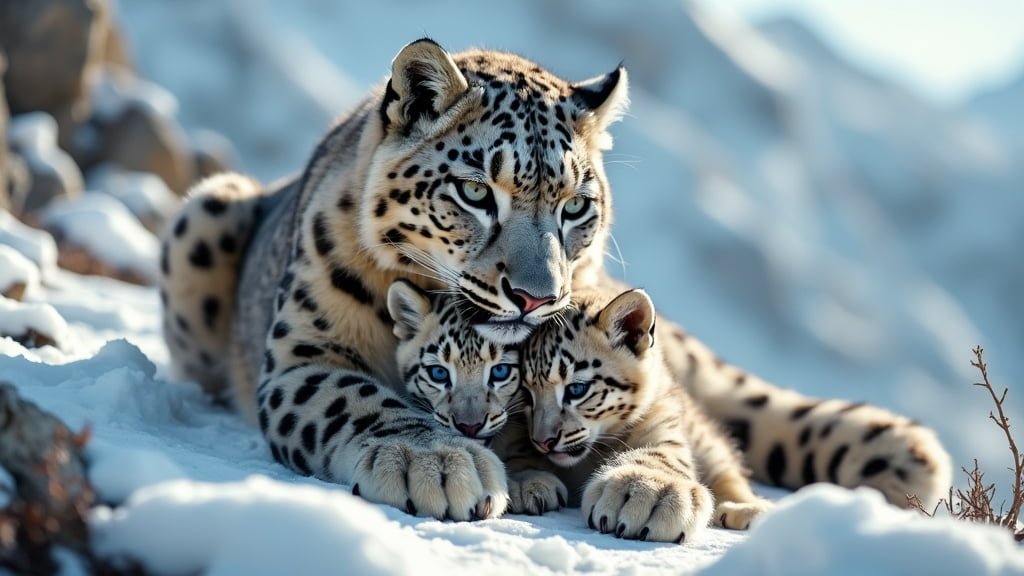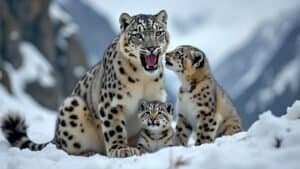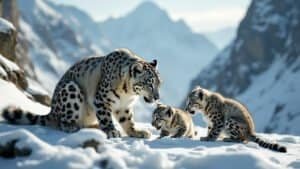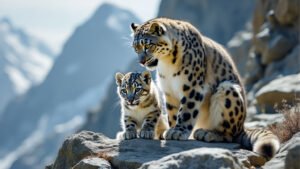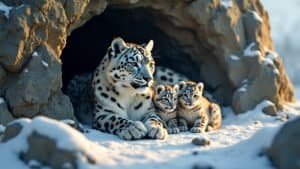Introduction
The survival and growth of snow leopard cubs are intricately linked to the health of their mothers. In the harsh environments where snow leopards thrive, maternal health plays a critical role in ensuring that cubs not only survive their early years but also develop into strong and capable adults
This article explores how various health factors in mother snow leopards—such as nutrition, illness, and stress—directly influence the fate of their cubs. We will also examine the importance of maternal behavior and age, and consider the potential long-term effects of poor maternal health on snow leopard cubs
Specific Health Factors Affecting Cub Survival
The survival of snow leopard cubs is deeply influenced by the health of their mothers, who must endure the challenging conditions of their high-altitude habitats
Cubs are highly dependent on their mothers during the first few months of life, relying on them for warmth, protection, and sustenance. Any decline in the mother’s health can have immediate and potentially fatal consequences for her offspring
This section will explore the specific health factors—such as nutrition, disease, and stress—that critically affect the survival rates of snow leopard cubs
The Impact of Nutrition on Maternal Health
Nutrition is a fundamental factor in the health of snow leopard mothers, directly influencing their ability to care for their cubs. A well-nourished mother is more likely to produce sufficient milk, which is vital for the growth and development of her cubs
According to a study by Kachel et al. (2017), snow leopards with access to a stable prey base tend to have healthier offspring. In contrast, mothers facing food scarcity are more prone to malnutrition, which can lead to reduced milk production and lower survival rates among cubs
Malnutrition can also weaken the mother’s immune system, making her and her cubs more susceptible to diseases
The Influence of Disease and Parasites on Maternal Condition
Diseases and parasites pose significant threats to the health of snow leopard mothers, subsequently affecting the survival of their cubs. A study by Naess et al. (2019) found that parasitic infections in snow leopards are more common in areas where prey is scarce, as weakened animals are more vulnerable to parasites
These infections can lead to anemia, weight loss, and overall poor health, reducing the mother’s ability to nurture her cubs. Furthermore, diseases such as feline distemper can spread from mother to cub, with potentially lethal consequences
Ensuring the health of the mother through monitoring and conservation efforts is therefore crucial to the survival of her cubs
Stress and Its Effects on Maternal and Cub Health
Stress is another critical factor that can negatively impact the health of snow leopard mothers and their cubs. Stress in snow leopards can be caused by a variety of factors, including human encroachment, habitat loss, and competition with other predators
When a mother snow leopard is stressed, her body may produce higher levels of cortisol, a hormone that can impair immune function and reduce reproductive success. According to a study by Blumstein et al. (2021), prolonged exposure to stress can lead to decreased maternal investment in cubs, such as reduced time spent hunting or caring for them
This reduction in maternal care can have severe consequences for the cubs, including stunted growth and increased mortality
The health of snow leopard mothers is critical to the survival of their cubs. Nutrition, disease, and stress are key factors that can significantly impact the mother’s ability to raise her offspring successfully. Conservation efforts that focus on ensuring a stable prey base, monitoring disease, and minimizing stressors are essential for the continued survival of snow leopard populations
The Role of Maternal Behavior in Cub Development
Maternal behavior is a crucial determinant in the survival and growth of snow leopard cubs. A mother snow leopard’s ability to protect, nurture, and teach her cubs significantly impacts their development and chances of survival in the wild
This section delves into the various maternal behaviors that are essential for cub development, including protective instincts, nursing practices, and socialization processes
Protective Behavior and Its Importance
One of the most critical aspects of maternal behavior in snow leopards is the protection of cubs from potential threats. Snow leopard mothers are highly vigilant, constantly monitoring their environment for signs of danger
This protective behavior is vital, especially in the early weeks of a cub’s life when they are most vulnerable to predators, harsh weather conditions, and accidents. A study by Suryawanshi et al. (2020) found that snow leopard cubs are often kept hidden in secluded dens by their mothers, minimizing the risk of predation
The mother’s ability to select safe and strategic den sites is a key factor in ensuring the cubs’ survival during these critical early stages
Nursing Practices and Cub Growth
Nursing is another fundamental aspect of maternal behavior that directly influences the growth and development of snow leopard cubs. The quality and quantity of milk provided by the mother are essential for the cubs’ health
Proper nursing not only nourishes the cubs but also helps in the development of their immune systems. According to McCarthy et al. (2018), cubs that receive adequate milk during the nursing period have a higher survival rate and better overall health
However, if the mother is malnourished or stressed, her milk production may be insufficient, leading to weaker cubs who are more susceptible to diseases and slower in reaching developmental milestones
The Influence of Maternal Socialization on Cubs
Beyond physical care, the socialization provided by the mother is crucial for the cubs’ development. Through play and interaction, cubs learn essential survival skills such as hunting, navigating their environment, and interacting with other snow leopards
The mother plays a central role in teaching these skills, gradually introducing her cubs to more complex tasks as they grow
Blumstein et al. (2021) highlighted that cubs raised by mothers who actively engage in socialization tend to be more successful in their independent lives once they leave the den. In contrast, cubs that receive less social interaction and instruction from their mothers may struggle to survive on their own
Maternal behavior is a key factor in the development of snow leopard cubs, influencing their ability to survive and thrive in the wild. The protective instincts of the mother, her nursing practices, and the socialization she provides are all essential components of this process. Ensuring that snow leopard mothers can exhibit these behaviors effectively is crucial for the conservation of this endangered species
Impact of Maternal Age on Cubs’ Health
The age of a mother snow leopard plays a significant role in the health and survival of her cubs. Maternal age can influence various aspects of reproduction, including the mother’s physical condition, her experience in raising cubs, and the overall health outcomes for her offspring
In this section, we will explore how maternal age affects cub health, comparing the experiences of first-time mothers with those of older, more experienced mothers, and examining the challenges associated with advanced maternal age
Age-Related Decline in Maternal Health
As snow leopards age, their overall health and physical condition may decline, impacting their ability to care for cubs effectively. Older snow leopard mothers might experience reduced fertility, lower energy levels, and a higher susceptibility to diseases, all of which can affect their capacity to provide adequate care for their cubs
According to a study by Naess et al. (2019), older female snow leopards often face increased risks of pregnancy complications, such as difficulties during labor or reduced milk production, which can directly impact the survival rates of their cubs
This decline in maternal health with age can lead to smaller litter sizes, weaker cubs, and a lower likelihood of cubs reaching maturity
Comparing First-Time and Experienced Mothers
The experience level of a mother snow leopard is another critical factor influencing cub health. First-time mothers may lack the experience needed to successfully rear cubs, leading to higher mortality rates among their offspring
Inexperienced mothers may struggle with selecting safe den sites, adequately protecting their cubs from predators, or providing sufficient nourishment through nursing. On the other hand, more experienced mothers, who have raised multiple litters, often exhibit better maternal behaviors, such as more effective hunting strategies and stronger protective instincts
McCarthy et al. (2018) found that cubs of experienced mothers generally have higher survival rates and better overall health compared to those born to first-time mothers
The Influence of Advanced Maternal Age on Cub Vitality
Advanced maternal age can pose significant challenges to the health and vitality of snow leopard cubs. Older mothers may not only have reduced physical capabilities but may also face complications that affect the genetic quality and robustness of their offspring
Studies have shown that cubs born to older mothers might experience slower growth rates, lower birth weights, and increased vulnerability to environmental stresses. Furthermore, the likelihood of age-related genetic mutations increases with maternal age, potentially leading to congenital health issues in the cubs
According to research by Suryawanshi et al. (2020), these challenges are particularly pronounced in snow leopard populations where older mothers may be more common due to skewed age distributions caused by environmental pressures and human impacts
Maternal age is a significant factor in the health and survival of snow leopard cubs. While older, experienced mothers tend to provide better care for their cubs, the physical decline associated with aging can present challenges
First-time mothers, although younger, may lack the experience necessary for successful cub rearing. Conservation strategies aimed at supporting both young and old mothers could be crucial in ensuring the survival and health of snow leopard populations
Long-Term Effects of Poor Maternal Health on Cubs
The health of a mother snow leopard not only impacts the immediate survival and growth of her cubs but can also have long-lasting effects that extend into their adult lives. Cubs born to mothers who suffer from malnutrition, illness, or chronic stress may experience developmental challenges that persist beyond their early years
This section examines the potential long-term effects of poor maternal health on snow leopard cubs, focusing on developmental issues, long-term behavioral and health impacts, and insights from case studies and field observations
Developmental Challenges in Cubs
Cubs born to mothers with poor health often face significant developmental challenges. These challenges can manifest in various ways, including stunted physical growth, delayed cognitive development, and impaired immune function
For instance, if a mother is unable to provide sufficient nutrition during the critical nursing period, her cubs may struggle to gain weight at the normal rate, leaving them weaker and more vulnerable to diseases
According to Kachel et al. (2017), malnourished cubs are less likely to develop the necessary strength and stamina required for hunting and surviving in the harsh mountainous environments snow leopards inhabit. These early developmental setbacks can have cascading effects, making it more difficult for the cubs to compete with other predators and secure their own territory once they reach adulthood
Long-Term Behavioral and Health Impacts
The effects of poor maternal health can also influence the long-term behavior and overall health of snow leopard cubs. Cubs who experience early stress or inadequate maternal care may develop behavioral issues, such as increased aggression, anxiety, or difficulty in social interactions with other snow leopards
These behavioral problems can hinder their ability to form alliances or mate successfully, which are critical for survival in the wild. Additionally, chronic health issues stemming from a poor start in life—such as weakened immune systems or recurring illnesses—can reduce their lifespan and reproductive success
Research by Blumstein et al. (2021) indicates that snow leopards raised under suboptimal maternal conditions often exhibit higher mortality rates and lower reproductive success, further endangering already vulnerable populations
Case Studies and Observations from the Wild
Field studies and observations of snow leopard populations provide valuable insights into the long-term consequences of poor maternal health
In some documented cases, cubs born to stressed or malnourished mothers have been observed to exhibit unusual behaviors, such as increased dependence on maternal support well into their juvenile years, or an inability to establish their own territories
These behaviors suggest a lingering impact of early-life adversity. Suryawanshi et al. (2020) documented several instances where cubs from mothers in poor health were unable to survive their first winter after leaving the den, highlighting the critical importance of maternal health not only for immediate survival but for long-term viability
Such case studies emphasize the need for conservation efforts that address both immediate and long-term factors affecting snow leopard populations
The long-term effects of poor maternal health on snow leopard cubs are profound and multifaceted. Developmental challenges, lasting behavioral impacts, and increased health risks can significantly reduce the chances of cubs reaching adulthood and contributing to the population
Understanding these long-term effects is crucial for developing effective conservation strategies that ensure the survival and thriving of snow leopards in the wild
Conclusion
The health of mother snow leopards is a critical factor that directly influences the survival and growth of their cubs. From the quality of nutrition and the impacts of disease and stress, to the age and maternal behaviors exhibited by the mother, each aspect plays a significant role in shaping the fate of snow leopard cubs
Healthy mothers are better equipped to protect, nourish, and teach their cubs, ensuring they develop the skills necessary for survival in harsh environments. Conversely, poor maternal health can lead to immediate risks such as malnourishment and illness, as well as long-term challenges like stunted growth and behavioral issues that persist into adulthood
Understanding these dynamics is essential for the conservation of snow leopards, emphasizing the importance of supporting maternal health through targeted conservation efforts. By ensuring that mother snow leopards remain healthy, we can help secure the future of this endangered species and the survival of their cubs in the wild
